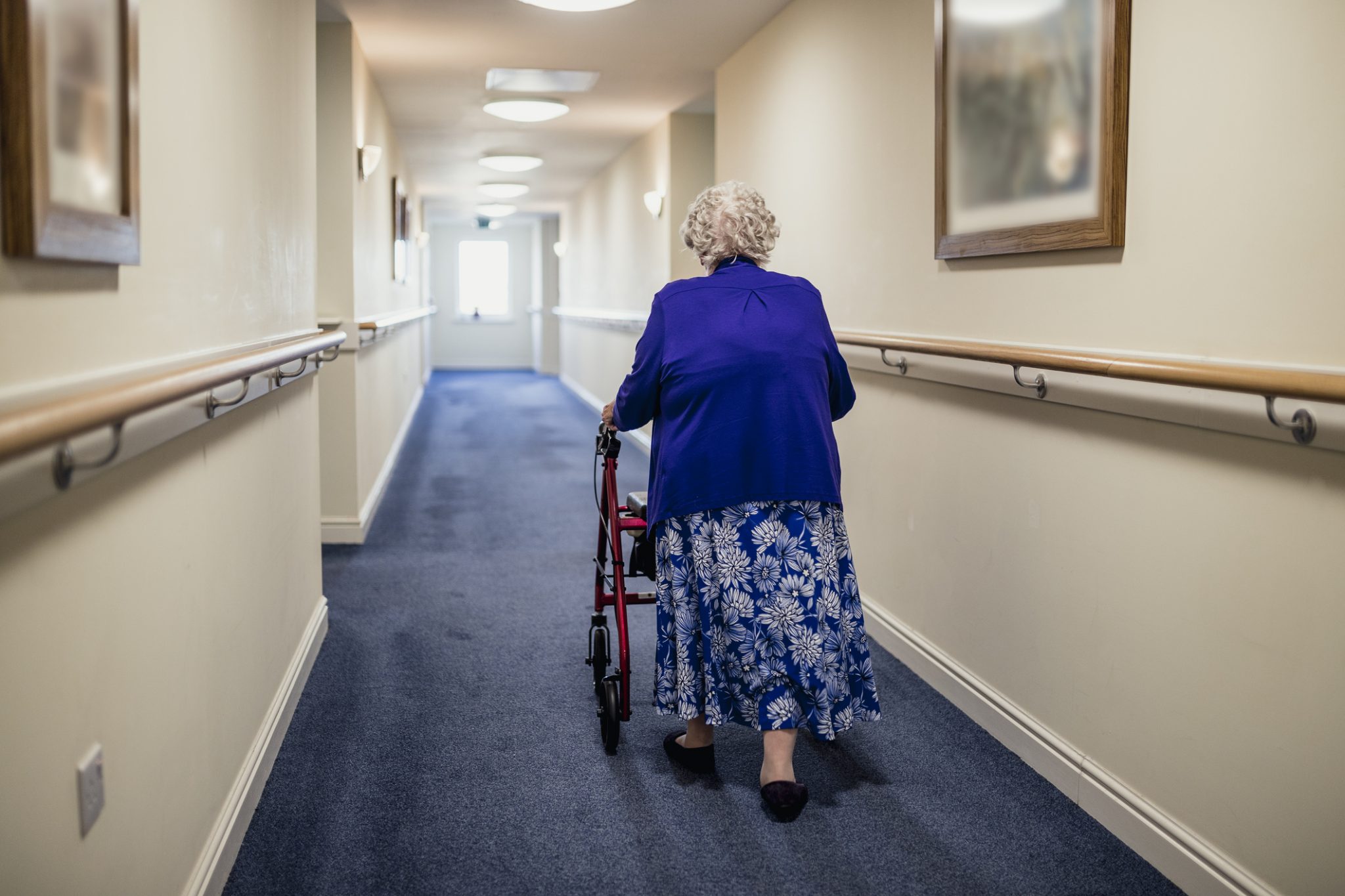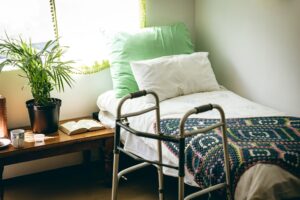Coronavirus crisis in care homes

Care homes have been harder hit than any other branch of the health service by coronavirus. What went wrong?
From early on in the Covid-19 pandemic it was recognised that older adults were disproportionately more at risk of serious illness if they caught the virus. Care homes could have expected to be among the most urgently supported sectors of the health service. Instead, they felt forgotten with around 15,500 deaths in care homes between March and August attributed to Covid-19.
Public Health England (PHE) guidance published on 25 February stated that ‘it remains very unlikely that people receiving care in a care home or the community will become infected’. The advice was scrapped on 13 March. But by that time the virus had started to spread. Already 798 cases had been confirmed in Britain and 10 people had died. Then the Department of Health and Social Care (DHSC) issued advice to care homes on 2 April to take on discharged hospital patients, some of who ‘may have Covid-19’. Figures from NHS England later showed that 25,060 patients were discharged from hospitals to care homes between 17 March and 16 April without knowing whether they had the virus.
A hard-hitting report from the Public Accounts Committee at the end of July said advising hospitals to discharge thousands of patients into care homes without knowing if they had the virus was a ‘reckless, appalling’ policy error.
Social care has long been underfunded, with many in the sector feeling like the poor relation to their NHS colleagues. Spending has fallen in real terms by 2% since 2009/10. In 2019, an Association of Directors of Adult Social Services (ADASS) survey found 75% of councils reported providers in their area had closed, stopped trading or handed back contracts in the previous six months. When Boris Johnson was elected Prime Minister, he announced he would finally ‘fix the crisis in social care’.
But any plan to do that seemed way off when on 6 March the health secretary Matt Hancock wrote to MPs asking them to submit ‘proposed solutions’ for the sector. This was after the Government had already delayed its social care green paper seven times since the first deadline of summer 2017.
The Government announced this month that it is creating a new adult social care chief nurse role, to provide more leadership to the sector. It has also promised to provide free PPE for homes this winter. The effectiveness of these measures is still to be seen.
Certainly, Covid-19 has highlighted that social care has been underfunded for years and is badly in need of reform. Here we look at what went wrong in the care sector during the first few months of the coronavirus crisis – and what those much-needed reforms should look like.
‘Too little, too late’

The chief scientific adviser Sir Patrick Vallance admitted to the Health and Social Care Committee in July that care homes had been ‘flagged up very early on’ as a concern during the pandemic, at least as early as February.
But it was not until 2 April the DHSC issued guidance to care homes to limit visits to residents. By 17 April there were 2,906 deaths involving Covid-19 in English care homes, according to Office for National Statistics (ONS) data. ONS figures also show between 2 March and 12 June 19,394 (29.3%) of 66,112 deaths in care homes in England and Wales were due to the disease.
Related Article: NHS 10-year plan: What does it mean for nursing?
It was not just visitors who could have brought the virus to homes. Care homes had clearly taken in patients who had Covid-19 from hospitals. Mandatory testing prior to admission to a care home was not brought in until 16 April but two surveys conducted between May and August, published in August, confirmed homes had sometimes knowingly taken in Covid patients before that and had often been pushed into doing so.
Jessie (not her real name), a manager of a care home in the West Midlands, tells Nursing in Practice that hospitals put care homes ‘under pressure’ to accept patients who were positive or untested for Covid-19.
Jane (not her real name), a manager of a care home in West Sussex and a registered nurse reflects: ‘Being expected to take in Covid-positive residents and then being slated when people died in high numbers in the homes is soul destroying.’ A Queen’s Nursing Institute (QNI) charity survey showed 21% of 163 UK care homes had taken positive Covid-19 patients from hospitals in the spring.
‘What’s the point of asking care homes to do something when you’re not going to provide the equipment?’ Care home manager
On 3 July, care homes were told to test staff each week and residents every 28 days. Jessie says this shows the Government does not understand the care home sector. She explains it is harder to test some residents because they may be confused by the testing. ‘Matt Hancock wants me to stick the swab down the throat of someone who has dementia? It’s not going to happen,’ she says.
She and other care home managers also reported not receiving enough testing kits to test residents and staff. The Government did not introduce the weekly testing for staff as promised over the summer because of the delays in delivering the testing kit. Jessie adds: ‘What’s the point of asking care homes to do something when you’re not going to provide the equipment?’
It is well documented that supply of personal protective equipment (PPE) to care homes was patchy. The QNI survey, carried out in May and June, found a third of UK care homes did not always have access to PPE.
Jessie says: ‘With PPE, it was tricky, particularly at the beginning, and people donated to us and made masks for us, which helped.’ She also laments that the NHS guidance that care workers did not need to wear PPE around asymptomatic patients was not withdrawn until 13 May: ‘It was common sense that you should wear masks even with asymptomatic residents, so we were already doing it in our home. We’d already hit the peak when the guidance finally came. A matter of too little, too late.’
Care homes have also been struggling with staff numbers, a situation made much worse by sickness and self-isolation. Vacancies across the social care sector already stood at 122,000 (7.8% of the total workforce) before the pandemic, according to Skills for Care in 2019. In August, the Health for Care coalition wrote to the Prime Minister, criticising the ‘unacceptable pressures’ in the first wave of the pandemic. The letter said: ‘This is a fractured, under-staffed and under-funded system in desperate need of reform.’
The high use of agency staff in care homes – a direct result of staff shortages – has since been identified as a key factor in the fast spread of Covid-19 between care homes. The ONS found in July that residents in care homes that used bank or agency nurses or carers most days or every day were 1.58 times more likely to test positive for Covid-19 than those in homes that did not use such staff. Yet some care homes have fared a little better over the last few months, in terms of Covid cases, and it seems they are those that ignored government guidance.

Boris Johnson claimed in May that the Government ‘brought in lockdown in care homes ahead of the general lockdown’, which was ordered on 23 March. But the Prime Minister was referring to advisory guidance, issued on 13 March, that said care home providers should ask ‘no one to visit who has suspected Covid-19 or is generally unwell’.
Mike Padgham, who runs four homes in North Yorkshire and is chair of the Independent Care Group, explains that he put his homes under lockdown earlier than the Government had instructed. ‘We were aware that the biggest danger to our residents was people coming in from outside,’ he says.
Jessie, in the West Midlands, did the same: ‘It was a massive decision to make, to shut down the home on 3 March, but I think we were more protected because we were faster than the guidelines.’
And Jane says she also went against government guidance: ‘Had I left locking down the home fully to the date that the Government gave us, we may have ended up with positive cases.’ She continues: ‘Many managers made their own decisions long before guidance was even published. Guidance has been coming thick and fast to the point that at times you feel you are drowning in it and had to wade through what was current and what was not.’
‘Sleepless nights’
However, across the sector, even in care homes with few or no cases, staff have felt the strain.
‘One of the things we need to acknowledge is the enormous emotional challenges this has brought for care home staff,’ says Professor Martin Green, chief executive of Care England, which represents independent care homes. ‘It’s not recognised enough.’
Jessie, who has started to suffer from anxiety herself, says the treatment of care homes has taken its toll on staff: ‘One staff member had to resign because their mental state was so bad.’ (See cover feature, page 10). Although her care home has had no positive Covid-19 cases, Jessie worries every day that one Covid-positive patient could turn into ‘four, then six, then nine, then 15 residents’. On top of the endless worry is the endless workload: ‘From becoming hairdressers, to carrying out activities instead of people we usually hire, and doing nursing jobs such as dressing… My staff have been going above and beyond for months now.’
Related Article: How could future nurses use robots to help deliver care?
Although it may look like the Government has done more to help the sector recently – with pledges to test residents and staff – Jane says: ‘We seem to be no further forward than six months ago. I have struggled with the additional workload and I know many other managers who are handing in their notice as their job role has become far too much.’
‘The toll taken on everyone has been huge and will take a long time to recover from.‘ Care home manager
Louise Brady, a registered nurse and clinical nurse development lead supporting the Royal British Legion’s six care homes, says she is also ‘very concerned’ about the impact of the pandemic on staff wellbeing – particularly because of the deaths of residents: ‘The residents are like family for many of those who work in care homes, so losing them is like a bereavement. It’s also been relentless with no rest. If there’s a second wave, there’ll be no recovery time.’
Often, too, relatives could not be with the resident who was dying – so care home staff had to ‘be that person who was there with them as they died’ and had to communicate with the family about what had happened.
Wellbeing support is highly variable across homes, Ms Brady says. Mr Padgham and his team now provide counselling for staff ‘to help them cope with the emotional strain’ and ‘sleepless nights’ of the pandemic. He explains: ‘We have lost four residents to Covid-19 and nursed many more back to health. The toll taken on everyone has been huge and will take a long time to recover from.’
Time for ‘radical change’
Social care has long felt forgotten. The pandemic showed this, with care homes ‘very much an afterthought,’ says Professor Green.
Mr Padgham agrees: ‘The Government placed all its attention on NHS healthcare, almost forgetting that big dangers lurked in social care, as was proved when the death statistics started to be revealed.’ An already financially fragile social care sector has been hit hard by Covid-19, with three-quarters (74%) of respondents to a National Care Association Survey released in May citing serious concerns about their viability going forward.
Jane tells Nursing in Practice that care homes ‘are expected to take funded residents on ridiculously low fees from local authorities’. The extra costs of the pandemic – such as sourcing PPE – have added to pressures. Age UK said in June some care homes were paying more than £100 a week for PPE.

Professor Green stresses: ‘I want the Government to have a radical and long-term view for social care. I don’t want them just to make tweaks.’
He is calling for a ‘very clear strategy on how you fund care into the future’, covering everything from replacing buildings – ‘many of which are coming to the end of their life’ – to filling vacancies and reducing staff turnover. Staff must receive better psychological support, pay and training, he adds. For example, variation in sick pay ‘has meant staff haven’t always made a properly informed choice about quarantining… I’d also like to see this as a platform for identifying a core skills and competencies framework for both health and social care, a training approach that enables people to understand their career pathway, clear career escalators and opportunities for people to move between health and social care.’
He warns: ‘Agency staff, who we found helped to spread Covid, were simply the product of an underfunded system. The bottom line is that if you had better pay and conditions, you’d attract more people.’
Related Article: What we do and don’t know about practice nurses being added to ARRS
Jessie sums up the frustration of the sector: ‘I wasn’t expecting much from the Government during the pandemic because not much attention is paid to us anyway.’
Mr Padgham underlines the importance of putting staff front and centre, not just in terms of pay but the ‘professional status of the job’ compared with their NHS counterparts, who often steal the headlines.
George Coxon, who owns care homes in Devon, echoed this sentiment, that social care needs better PR, when he wrote in a blog for Nursing in Practice: ‘We need to shout about what an amazing experience working as a social care nurse can be’.
But the better PR is hard without reform. And without reform, how can care home staff and residents be sure Covid, or another pandemic, will not hit them as badly again?
Mr Padgham concludes: ‘We need to see root-and-branch reform of social care, so that the sector is never in such a vulnerable position again.’

See how our symptom tool can help you make better sense of patient presentations
Click here to search a symptom




